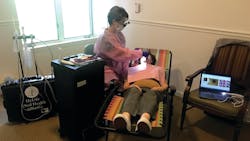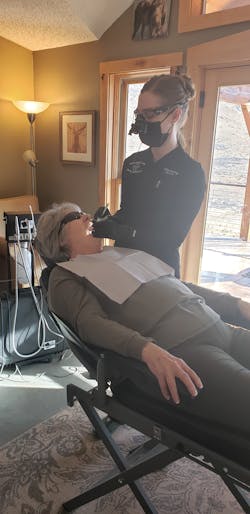Using teledentistry to improve access to care for seniors
According to the latest research from the Centers for Disease Control and Prevention,1 roughly 35% of seniors in the US did not take time for a dental visit in the last 12 months. Unsurprisingly, that percentage increases as a patient ages. If we seek to improve oral health for seniors, then we must first understand the barriers that prevent them from accessing our services. The American Dental Association has revealed that the number one barrier to accessing care for seniors is cost.2 Other notable significant barriers include “difficulty finding a dentist,” “inconvenient location/time,” and “no perceived need.” What will you do to reduce or remove these barriers in your practice? As the baby boomers continue to inflate the senior population, it will become increasingly important to create new solutions to meet their unique needs.
What if you were to send a hygienist out into the senior community? He or she could provide low-cost preventive services and screen patients for more definitive care, all while you remain in your own office. Teledentistry platforms allow the capture of patient images and data for your review, either at the same time (synchronously) or at a time in the near future (asynchronously). This isn’t charity; it’s a novel business model that’s already being tested in the field.
I spoke with two hygienists who are actively using teledentistry technology to reach underserved senior patients and provide the care they desperately need. In both cases, these hygienists are working in states that have relatively progressive laws regarding how registered dental hygienists can practice. The regulations for how team members can serve patients without direct supervision from dentists vary significantly, so check your local state dental practice act to see how this model can work for you.
Abigail Hughey, BSDH, RDH, Open Mobile Care
At this point, I have yet to locate a local dentist who is willing or able to provide mobile dentistry, though I do possess the technology. I purchased a mobile delivery unit (with a vacuum and compressor) from DNTLworks that includes a high-speed fiber-optic handpiece. I provide preventive hygiene services to the elderly population, whether in their homes or in assisted living or memory care facilities. I am not contracted with any particular facility, so it is all based on patients or their family members contacting me directly for my services.”
Angie Stone, bs, RDH, HyLife Oral Health Alliance (HOHA)
“We provide dental hygiene services for elders in Wisconsin who reside in skilled nursing facilities, assisted living communities, and memory care communities. Services are typically provided every six months. To support oral health in between dental cleanings, we perform professional oral care (brushing and cleaning between the teeth) on a weekly basis, as well as provide 100% xylitol-sweetened products to patients.
In the state of Wisconsin, hygienists do not require any supervision from a dentist to provide dental hygiene services in these settings—no collaborative agreements, no exam prior to treatment, no requirement of an eventual exam in order to continue care—like many other state statutes dictate. Wisconsin law opens up much-needed and deserved preventive services to our state’s elders.
That being said, I understand the value in working with a dentist. Many residents have rampant tooth decay, fractured teeth, fistulas, and retained root tips. As we know, a hygienist cannot address these issues. Taking intraoral images, sharing them with a dentist via a HIPAA-compliant platform such as MouthWatch, and then gaining the opinion of the dentist allows us to discuss needs with elder patients and/or their guardians. We can also determine whether the elder can leave the community for dental treatment, safely accept treatment, and if he or she has the means to pay for the care. If each of these conditions can be met, we are able to coordinate care with our local contracted teledentist.”
References
1. Kramarow EA. Dental care among adults aged 65 and over, 2017. NCHS Data Brief. 2019;(337):1-8.
2. Oral health and well-being among seniors in the United States. Health Policy Institute. American Dental Association. https://www.ada.org/~/media/ADA/Science%20and%20Research/HPI/Files/HPIgraphic_0916_2.pdf.
About the Author

Chris Salierno, DDS
Chief Dental Officer, Tend
Chris Salierno, DDS, is a general dentist from Long Island, New York. He graduated from Stony Brook School of Dental Medicine in 2005. Dr. Salierno lectures internationally on clinical dentistry, practice management, and leadership development. In 2017 he became a chief development officer with the Cellerant Consulting Group, and he was the chief editor of Dental Economics from 2014 to 2021. In 2021, he became the chief dental officer at Tend. He can be reached on Instagram @the_curious_dentist.
Updated May 13, 2022

